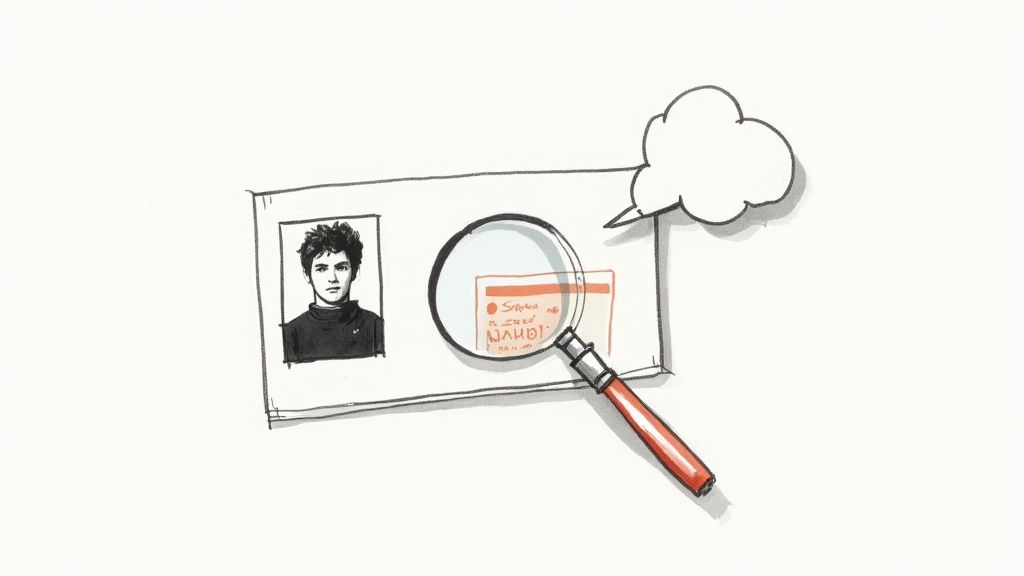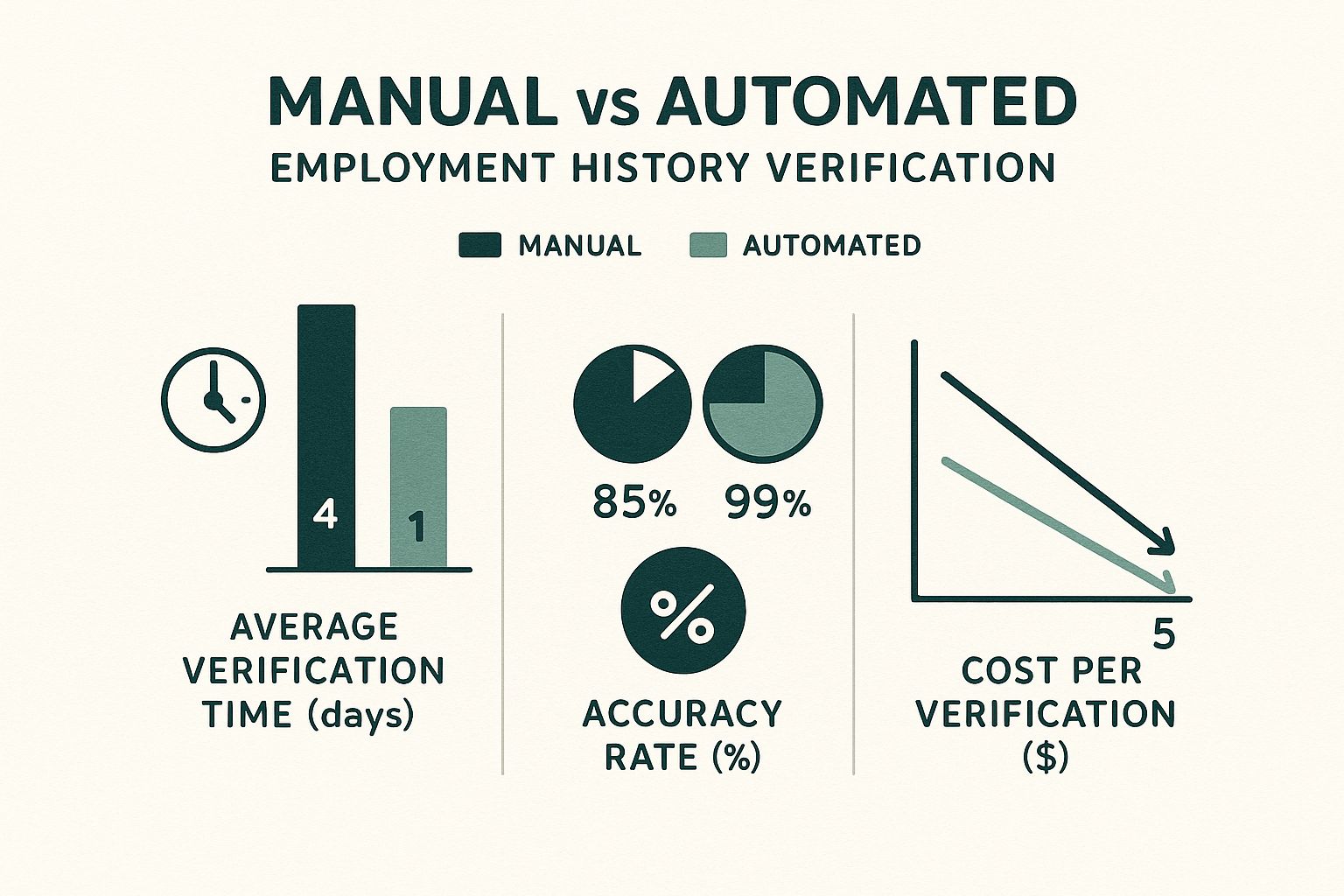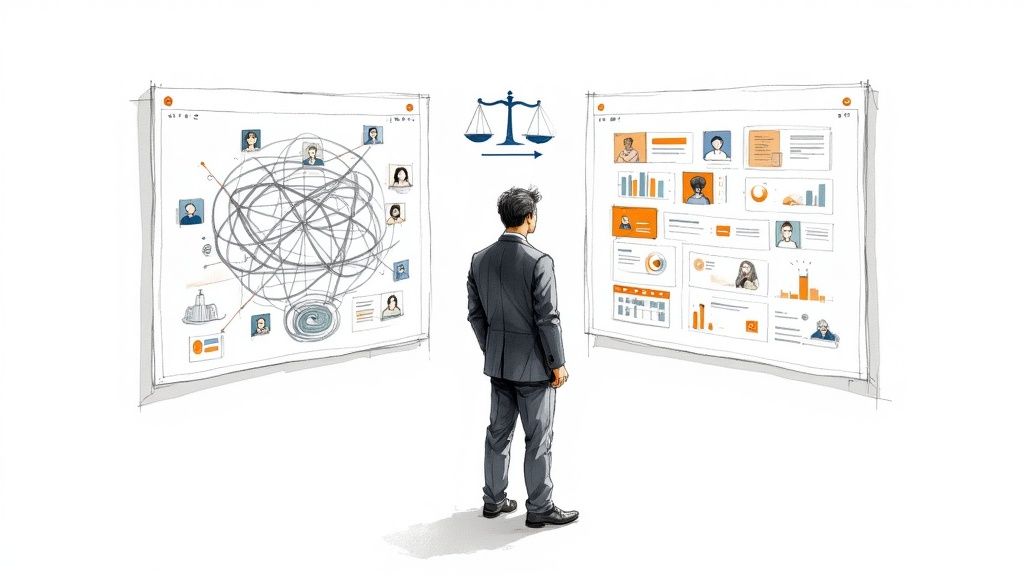Before you even think about running your first background check, you need a solid game plan. A truly effective pre-employment screening process isn't just a list of tasks to check off; it's a vital piece of your overall talent strategy. It has to walk that fine line between managing risk and creating a positive, welcoming experience for your candidates.
Without that strategic foundation, your screening efforts can quickly become inconsistent, legally risky, and, frankly, pretty useless.
First, Define Your Screening Policy
Think of your screening policy as your internal playbook. Its main job is to ensure every single candidate gets a fair and consistent shake, which is absolutely critical for staying on the right side of the law. This document can't be a vague, one-page statement. It needs to get into the weeds, detailing exactly what you check, for which roles, and why.
For instance, the background check for a junior marketing associate shouldn't look anything like the deep financial and criminal history dive you'd do for a new Chief Financial Officer. It just doesn't make sense. Your policy should establish clear tiers or packages of screenings that align with the specific risks and responsibilities of different jobs. This risk-based approach keeps you from over-screening for low-risk roles and, more importantly, under-screening for the high-impact ones.
To make sure your policy is rock-solid, you'll need to create a clear guide that outlines the core components. This ensures everyone on your team is on the same page and helps defend your process if it's ever challenged.
Core Components of a Screening Policy
A summary of the essential elements every screening policy must include to ensure consistency, fairness, and legal defensibility.
| Policy Component | Key Objective |
|---|---|
| Clear Scope and Purpose | State why the policy exists and which roles it applies to. |
| Tiered Screening Packages | Define specific checks for different job levels based on risk. |
| Adverse Finding Criteria | Clearly outline what constitutes a "red flag" that requires review. |
| Adjudication Process | Detail the step-by-step process for reviewing and making decisions on flags. |
| Adverse Action Procedure | Explain the legally compliant process for rescinding an offer. |
| Candidate Consent & Privacy | Document how you obtain consent and protect candidate data (e.g., GDPR, CCPA). |
| Compliance Statements | Acknowledge adherence to major regulations like the FCRA. |
Ultimately, a well-documented policy is your best defense. It demonstrates a thoughtful, standardized approach to screening that protects both the company and the candidate. It's also worth revisiting your policy annually to make sure it's still in line with current laws and your business needs. And remember, understanding the importance of conducting thorough background checks is the first step in building a program that truly protects your organization.
Next, Map the Candidate Journey and Get Everyone on Board
Let's be real: how a candidate feels during your screening process says a lot about your company. A clunky, slow, or confusing experience can scare off even the most excited applicant. You need to walk in their shoes. Map out every single touchpoint, from the moment they get the disclosure form to the final notification email.
Transparency is your best friend here. Tell candidates what you're checking and give them realistic timelines. This simple act of setting expectations can transform what feels like an interrogation into a professional, respectful part of the hiring journey.
A critical shift in hiring priorities is underway. While risk mitigation was once the top concern, speed has now become the most important factor for employers globally. This change is driven by the need to secure talent quickly in competitive markets and improve the overall candidate experience. Learn more about how automation is shaping global hiring trends.
Getting internal buy-in is just as crucial. Your legal and compliance teams need to give your policy their stamp of approval, ensuring it aligns with regulations like the FCRA and any local "ban the box" laws. Hiring managers also need to understand why the screening tiers exist for their teams.
When everyone is on the same page—from legal to the front-line managers—the entire process runs smoothly and achieves its goal without creating a bunch of internal headaches. This foundational work is, without a doubt, the most important part of building a modern screening program. It's the framework that supports every check you run and every hire you make.
Navigating Legal and Regulatory Compliance

Let’s be blunt. Stepping into pre-employment screening without a rock-solid grasp of legal compliance is like walking through a minefield blindfolded. The rules aren’t just suggestions; they’re strict requirements that form the very bedrock of a fair, consistent, and legally defensible hiring program.
Get this part wrong, and you're not just risking a slap on the wrist. You're looking at costly lawsuits and serious damage to your employer brand. The legal landscape is a tangled web of federal, state, and even local laws, and knowing how they all interact is non-negotiable for any HR pro managing the pre employment screening process.
Demystifying the Fair Credit Reporting Act
Here in the U.S., the Fair Credit Reporting Act (FCRA) is the main event. Don't let the name fool you. While it sounds like it only covers credit reports, its reach is much broader. It applies to nearly all third-party background checks, including criminal history, employment verification, and education checks.
The FCRA lays out a clear, non-negotiable process you have to follow, built on three core pillars:
- Disclosure: You must give the candidate a clear, standalone document stating you might run a background check. This can't be buried in the fine print of an application.
- Authorization: The candidate has to give you explicit, written consent to conduct the screening. This is a completely separate step from the disclosure.
- Adverse Action Process: If you find something in the report that might make you rescind a job offer, you must follow a specific two-step notification procedure.
The adverse action process is where so many companies stumble. It’s not just about ticking a compliance box; it’s about treating candidates with respect. Rushing this or failing to give the candidate a chance to respond is a fast track to a potential lawsuit.
This process starts with a "pre-adverse action" notice, which includes a copy of the report and a summary of their rights. You then must wait—typically five business days—before sending the final "adverse action" notice. This critical waiting period gives the candidate an opportunity to dispute any inaccuracies in the report.
The Rise of Ban the Box and Fair Chance Laws
On top of the FCRA, a growing number of states and cities have passed "ban the box" or fair chance laws. These rules change when you can ask about a candidate's criminal history. The whole point is to give people with a past record a fair shot to be judged on their qualifications first.
Typically, these laws mean you can no longer ask about criminal history on the initial job application. You have to wait until a later stage—often after a conditional job offer has been made.
Common Scenarios Where Ban the Box Applies:
- Application Stage: You remove the "Have you ever been convicted of a crime?" checkbox from your initial application for any roles in jurisdictions with these laws. It's a simple change, but a crucial one.
- Interview Stage: You conduct interviews focusing only on skills, experience, and qualifications. The topic of criminal history is completely off-limits. Even your best-intentioned managers need training on this. You can get them started with some helpful virtual interview tips to ensure they stick to a compliant script.
- Post-Offer Stage: Once you've extended a conditional offer, then you can kick off the criminal background check as part of your standard screening process.
Each jurisdiction has its own quirks and specific rules, so it is absolutely essential to work with your legal counsel to understand the requirements where you operate.
Handling Global and Ongoing Compliance
Hiring isn't confined by borders anymore. When your talent pool goes global, so do your compliance duties. A screening process that's perfectly fine in Ohio could be a massive GDPR violation in Germany. A one-size-fits-all approach just doesn't work.
You have to develop localized strategies that respect regional data privacy laws and cultural norms. This also extends beyond the initial hire. Employee rescreening has become increasingly important, especially with shifting regulations and a more mobile workforce. New laws are tightening scrutiny, requiring companies to keep records up-to-date or face major penalties.
To manage these varied obligations, a standardized, ongoing rescreening program is the only way forward. Ultimately, navigating this legal maze comes down to diligence, clear documentation, and a genuine commitment to fairness. Building a compliant process not only protects your organization but also strengthens your reputation as an employer of choice.
Executing Core Background Checks Accurately
Once you’ve locked down your legal framework, it’s time to move from planning to doing. This is where the rubber meets the road in the pre employment screening process—running the actual checks that confirm (or challenge) a candidate's history and qualifications. I can't stress this enough: accuracy is everything. A single mistake can lead to a bad hire, or worse, unfairly knock a great candidate out of the running.
This part of the process demands a methodical approach. You're not just ticking boxes; you're verifying the claims made on a resume or application. The most common verifications—criminal history, past employment, and education—each require a specific lens to interpret the findings correctly.
Conducting Essential Verifications
Criminal record checks often feel like the main event, but they're just one piece of a much larger puzzle. Verifying a candidate’s professional and academic history is equally crucial. Think of it as painting a complete picture of their reliability, honesty, and true qualifications.
Now, when you find a discrepancy, don't immediately assume the worst. It's not always a sign of a lie. A candidate might genuinely misremember the exact start date of a job from ten years ago. Or a university's registrar's office could be moving at a snail's pace. The key is having a consistent, professional process for handling these moments.
Here’s a practical look at common issues and how your team should handle them.
How to Handle Common Screening Discrepancies
| Discrepancy Type | Potential Cause | Recommended Action |
|---|---|---|
| Conflicting Employment Dates | Simple memory lapse, rounding up months/years on a resume, different company record-keeping. | Start with a non-accusatory conversation. Ask the candidate for clarification before making any judgments. |
| Unverified Degree | University records lag, maiden/married name mismatch, typo in the application details. | This is a big one. Initiate the pre-adverse action process. Give the candidate a copy of the report and a chance to provide their own proof, like a diploma or transcript. |
| Job Title Mismatch | Title inflation on the resume, legitimate difference between internal vs. external titles. | Have a direct conversation. Ask them to explain the difference. This can reveal a lot about their professional honesty. |
The goal here is to gather information, not to play "gotcha." Every inconsistency should be an opportunity for clarification before you make a final call.
The Critical Role of Identity Verification
In a world of remote work and increasingly clever fraud, just assuming a candidate is who they say they are is a massive risk. Identity verification isn't a "nice-to-have" anymore; it's a non-negotiable security measure. And recent data shows a concerning gap.
While nearly 90% of companies run criminal record checks, employers are now zeroing in on screening accuracy above all else. Yet, despite a surge in identity fraud—which 17% of companies reported experiencing—only 60% actually include identity verification. This is a huge vulnerability, especially when over 75% of companies find discrepancies like fake work histories. You can dive into more details in this 2025 global benchmark report from Hireright.com.
Validating a candidate's identity right at the start confirms you're screening the right person and acts as a powerful shield against fraud. Modern tools can quickly and securely confirm government-issued IDs, making the whole thing painless for both your team and the candidate.
This infographic breaks down just how much more efficient automated verification is compared to doing it all by hand.

The numbers speak for themselves. Automation doesn't just cut down on time; it drives up accuracy and brings down the cost for each verification. It’s a game-changer for any modern screening program.
Ultimately, getting background checks right comes down to diligence and fairness. When you combine robust verification methods with a consistent process for handling discrepancies, you build a reliable system that cuts risk while treating every candidate with the respect they deserve. This careful execution is what turns a simple checklist into a true strategic asset for your company.
Making Fair and Consistent Hiring Decisions

The background check report is in. Now the real work begins. This is that critical moment in the pre employment screening process where raw data gets translated into a hiring decision.
Let’s be honest: if you handle this stage poorly, you’re opening your company up to serious legal risks and a tarnished reputation. But when you get it right, you demonstrate a solid commitment to fairness and consistency that protects everyone involved.
These calls can't be gut feelings or snap judgments made in a vacuum. The entire point is to strip away individual bias and measure every single candidate against the same objective, job-related standards. A structured, well-thought-out approach isn't just a "nice-to-have"—it's your most valuable asset here.
Building Your Adjudication Matrix
The single most effective tool for this job is an adjudication matrix. Think of it as your company's official decision-making rubric. It standardizes how your team reviews background check findings, creating clear, black-and-white guidelines. This ensures every hiring manager evaluates potential issues with the same level of scrutiny.
This matrix isn't some generic, one-size-fits-all template you can just download. You'll need to tailor it to the specific risks and requirements tied to different roles in your company.
For example, a recent conviction for fraud is obviously a massive red flag for an accounting position. But that same finding might be far less relevant for a warehouse role with zero financial duties.
Your matrix should weigh several key factors for any potential issue:
- Nature of the Offense: What was the specific issue that came up?
- Time Passed: How long ago did the incident actually happen?
- Job Relevance: Does this offense directly relate to the core responsibilities of the job?
By creating this framework before you ever need it, you make sure decisions are driven by policy, not personal opinion. This documented, consistent process is the bedrock of a defensible and equitable hiring system.
The Individualized Assessment
Even with a perfect matrix, you can't just set it and forget it. The Equal Employment Opportunity Commission (EEOC) strongly encourages an individualized assessment for any candidate with a criminal record. This means you have to look beyond the charge itself and consider the person and their specific context.
This is your chance to weigh the bigger picture. You should consider the facts surrounding the offense, how old the candidate was at the time, any evidence of rehabilitation they can provide, and what their employment history looks like since the incident. It’s all about seeing the whole person, not just a line item on a report.
A critical step in maintaining objectivity during these reviews is using structured evaluation criteria. A standardized format helps ensure every reviewer is looking at the same factors, which is key for both consistency and compliance. To learn more about structuring your review process, check out our guide on creating an effective interview evaluation form.
Navigating the Adverse Action Process
So, what happens if, after a thorough review, you decide not to move forward with a candidate because of their report? You are legally required to initiate the adverse action process. This is a strict, two-step procedure mandated by the Fair Credit Reporting Act (FCRA) to protect the candidate's rights. You can't skip it.
The Pre-Adverse Action Notice
Before making anything final, you must send the candidate a pre-adverse action notice. This packet must contain a full copy of their background check report along with a summary of their rights under the FCRA.
The Waiting Period
Next, you have to wait a "reasonable" amount of time—the industry standard is five business days—to let the candidate review their report and dispute any inaccuracies with the screening provider. This pause is non-negotiable; it's a fundamental part of due process.
The Final Adverse Action Notice
If the candidate doesn't dispute the findings, or if their explanation doesn't change your decision, you can then send the final adverse action notice. This letter officially informs them that you will not be moving forward with their candidacy.
How you handle this process, especially when delivering bad news, speaks volumes about your company. Treating every single candidate with respect—even the ones you don't hire—is essential for protecting your employer brand.
Choosing Your Screening Technology Partner

Let's be honest. Trying to run a modern pre employment screening process by hand is a recipe for disaster. It's a direct path to costly mistakes, compliance nightmares, and a truly terrible candidate experience.
The right tech partner does more than just run background checks. They become an extension of your HR team, automating tedious workflows and acting as a crucial line of defense for your entire organization. This isn't just about picking the cheapest option; it's a strategic decision. You're looking for a partner whose platform and expertise will make your hiring process faster, safer, and far more efficient.
Identifying Must-Have Platform Features
Not all screening platforms are built the same. As you begin evaluating your options, you need to look past the basic criminal background check and pinpoint the features that will genuinely improve your day-to-day operations and the candidate’s journey.
Your shortlist of vendors should offer a suite of modern tools that are designed for how people hire today.
Key Features to Prioritize:
- A Mobile-First Candidate Portal: Most of your candidates will be on their phones. The platform absolutely must provide a smooth, mobile-friendly way for them to enter their info and sign consent forms. A clunky portal is a huge turn-off and can cost you great applicants.
- Deep ATS Integration: Your screening tool needs to talk to your Applicant Tracking System seamlessly. This is critical for eliminating manual data entry, cutting down on errors, and keeping all your candidate data in one central hub.
- Real-Time Status Updates: You and your candidates should never be left wondering what's going on. A good platform offers a live dashboard showing the exact status of every check, from "in progress" to "complete."
- Built-in Compliance Tools: The technology should have compliance baked right into its DNA. This means providing compliant disclosure and authorization forms, helping you manage adverse action notices, and adapting to new regulations as they pop up.
These features aren't just nice-to-haves; they form the foundation of a modern, efficient screening program. They directly tackle the biggest frustrations for both HR teams and candidates, transforming a slow, anxiety-ridden process into one that’s smooth and transparent.
Vetting Vendors Like a Pro
Once you've got a list of potential partners with the right features, the real detective work begins. This is where you dig deep to check out their reliability, security, and the actual quality of their service. Remember, you're looking for a partner you can trust with highly sensitive information and critical hiring decisions.
A crucial part of this evaluation is ensuring the vendor's technology can handle document-heavy workflows efficiently. When selecting a technology partner, prioritize vendors offering robust solutions such as document automation software to streamline the generation of reports, contracts, and other essential paperwork.
To make a smart choice, you've got to ask the tough questions and demand clear answers.
Your Vendor Vetting Checklist:
- Compliance Expertise: How do they keep up with the constant changes in laws like the FCRA and local "ban the box" rules? Ask for specific examples of how they’ve helped other clients through tricky compliance situations.
- Data Security Protocols: Is the vendor SOC 2 compliant? This should be a non-negotiable standard for data security. Dig into their data encryption methods and privacy policies to make sure they can protect your candidates’ sensitive info.
- Average Turnaround Times: Get the real numbers. Ask for their average completion times for different checks (like a county criminal search versus an employment verification). A transparent provider will be open about their metrics and what might cause delays.
- Customer Support Quality: What happens when you need help? Can you get a dedicated account manager? Test their support team's responsiveness while you're still in the evaluation phase. The last thing you want is a partner who goes silent when you have an urgent problem.
Beyond this checklist, take a hard look at their pricing. Don't get tricked by the lowest price tag. Analyze their models—whether it’s per-check, bundled packages, or a subscription—to truly understand the total cost. A slightly higher price for a more reliable, secure, and supportive partner is an investment that always pays for itself.
In fact, many organizations find that using specialized tools for the initial stages can be highly effective. You can learn more about how to structure this in our guide to automated candidate screening.
Common Questions About Pre Employment Screening
When you’re deep in the weeds of building out your pre-employment screening process, it’s natural for a lot of specific questions to pop up. Getting clear, practical answers is key to keeping things running smoothly and, most importantly, compliantly. Here are some of the most common questions we hear from HR teams and business leaders, along with our experienced take on them.
How Long Should a Background Check Take?
This is one of those "it depends" answers, but for good reason. The timeline for a background check is completely dictated by the specific searches you’re running.
Simple database searches, like a national criminal database check, can come back almost instantly. However, the more detailed and reliable checks almost always require some manual work. For instance, a county-level criminal search or an employment verification typically takes 3-5 business days. This delay happens because we're waiting on a real person—a court clerk or a previous HR manager—to pull the record and respond.
And if you’re vetting a candidate who has lived or worked abroad, international checks can stretch that timeline even further. The best thing you can do is be upfront with your candidates about the process and give them a realistic window from the very beginning.
What if a Candidate Lied on Their Application?
Discovering a discrepancy on a background check doesn't automatically mean you pull the plug on the offer. It's a serious situation, but you have a legal obligation to handle it a certain way, guided by the Fair Credit Reporting Act’s (FCRA) pre-adverse action process. This isn't optional; it's a critical step.
First, you must inform the candidate in writing that you’ve found something concerning. You'll need to provide them with a copy of their background check report and a summary of their rights, which includes the right to dispute the information. This gives them a chance to clear up what could be an honest mistake or a data entry error from the source.
If their explanation doesn't hold up and the lie is material to the job—like faking a required license or degree—only then can you move forward with the final adverse action notice. The absolute key here is consistency. Whatever you decide, make sure you apply the same standard to every single candidate to avoid any hint of discrimination.
A background check focuses on verifying objective, hard data from official sources—think criminal records, education history, or past employment dates. A reference check, on the other hand, is all about qualitative insight. It’s a conversation with former managers or colleagues to learn about a candidate's soft skills, work ethic, and on-the-job performance. One confirms what they did, while the other explores how well they did it.
Can We Run Checks on Current Employees?
Yes, you can, and in many industries, you probably should. This practice is often called rescreening or continuous monitoring, and it’s becoming a standard for managing insider risk. It's especially smart for employees moving into sensitive roles, getting a promotion with new responsibilities, or those who handle finances or data.
But you can't just run these checks on a whim. You need a legally permissible reason and, in most cases, you’ll need to get renewed consent from the employee. Your best defense is a crystal-clear, written policy that details who gets rescreened, how often, and why.
To steer clear of any discrimination claims, this policy has to be applied fairly and consistently to all employees in similar positions. This protects both the company from legal trouble and your employees from feeling singled out.
The pre employment screening process has a lot of moving parts, but the right technology can lift a huge weight off your shoulders. Async Interview automates the initial video screening stage, letting you focus your valuable time on the top-tier candidates your background checks have helped you identify. We handle the top of the funnel so you can shortlist qualified talent faster and more effectively.




